SKODA OCTAVIA 2009 2.G / (1Z) Workshop Manual
Manufacturer: SKODA, Model Year: 2009, Model line: OCTAVIA, Model: SKODA OCTAVIA 2009 2.G / (1Z)Pages: 304, PDF Size: 19.56 MB
Page 51 of 304
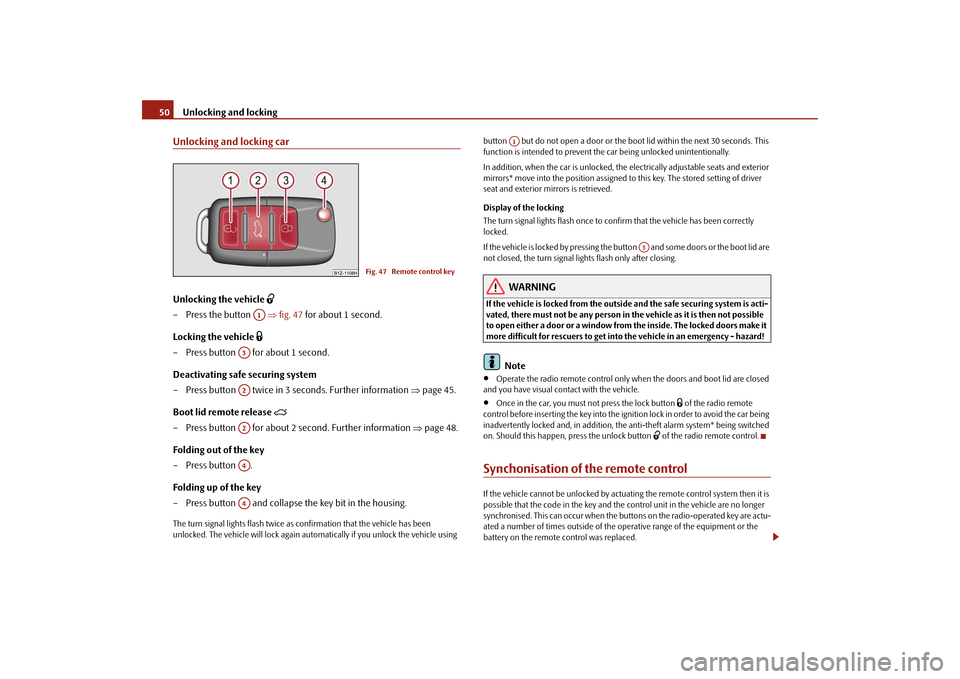
Unlocking and locking
50
Unlocking and locking carUnlocking the vehicle
– Press the button
⇒
fig. 47
for about 1 second.
Locking the vehicle
– Press button for about 1 second.Deactivating safe securing system – Press button twice in 3 seconds. Further information
⇒
page 45.
Boot lid remote release
– Press button for about 2 second. Further information
⇒
page 48.
Folding out of the key – Press button . Folding up of the key – Press button and collapse the key bit in the housing.The turn signal lights flash twice as
confirmation that the vehicle has been
unlocked. The vehicle will lock again auto
matically if you unlock the vehicle using
button but do not open a door or the b
oot lid within the next 30 seconds. This
function is intended to prevent the car being unlocked unintentionally. In addition, when the car is unlocked, the el
ectrically adjustable seats and exterior
mirrors* move into the position assigned to this key. The stored setting of driver seat and exterior mirrors is retrieved. Display of the locking The turn signal lights flash once to co
nfirm that the vehicle has been correctly
locked. If the vehicle is locked by
pressing the button and some doors or the boot lid are
not closed, the turn signal lights flash only after closing.
WARNING
If the vehicle is locked from the outsid
e and the safe securing system is acti-
vated, there must not be any person in the vehicle as it is then not possible to open either a door or a window from the inside. The locked doors make it more difficult for rescuers to get into
the vehicle in an emergency - hazard!
Note
•
Operate the radio remote control only when the doors and boot lid are closed
and you have visual co
ntact with the vehicle.
•
Once in the car, you must
not press the lock button
of the radio remote
control before inserting the key into the ignition lock in order to avoid the car being inadvertently locked and, in addition, the anti-theft alarm system* being switched on. Should this happen, press the unlock button
of the radio remote control.
Synchonisation of the remote controlIf the vehicle cannot be unlocked by actuatin
g the remote control system then it is
possible that the code in the key and the
control unit in the vehicle are no longer
synchronised. This can occur when the buttons on the radio-operated key are actu- ated a number of times outside of the operative range of the equipment or the battery on the remote control was replaced.
Fig. 47 Remote control key
A1
A3A2A2A4A4
A1
A3
se0.1.book Page 50 Friday, April 10, 2009 3:19 PM
Page 52 of 304
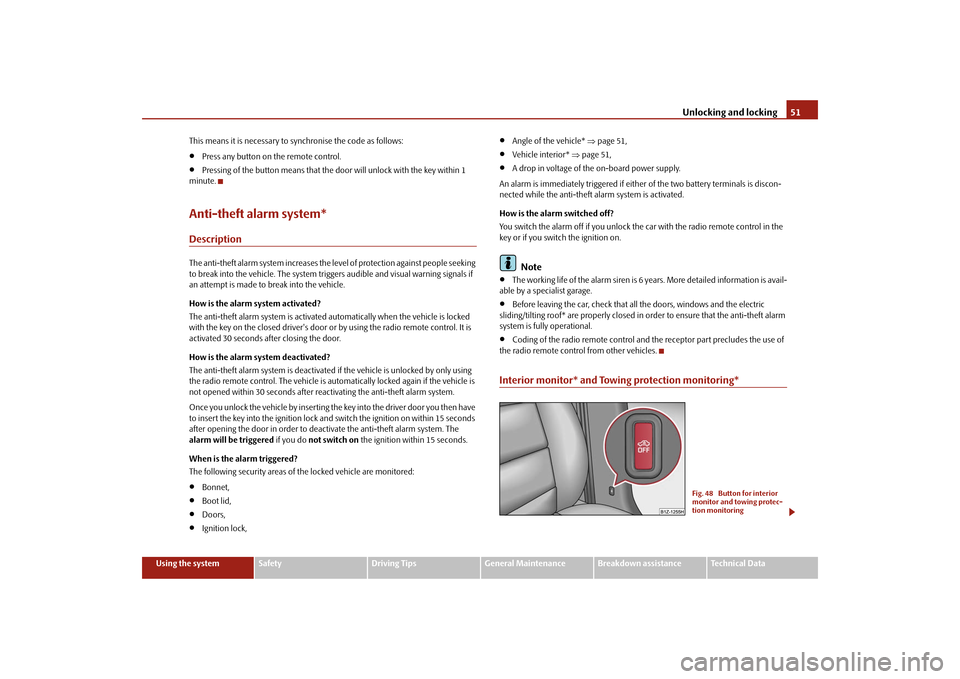
Unlocking and locking
51
Using the system
Safety
Driving Tips
General Maintenance
Breakdown assistance
Technical Data
This means it is necessary to synchronise the code as follows:•
Press any button on the remote control.
•
Pressing of the button means that the
door will unlock with the key within 1
minute.Anti-theft alarm system*DescriptionThe anti-theft alarm system increases the le
vel of protection against people seeking
to break into the vehicle. The system tri
ggers audible and visual warning signals if
an attempt is made to break into the vehicle. How is the alarm system activated? The anti-theft alarm system is activated
automatically when th
e vehicle is locked
with the key on the closed driver's door or
by using the radio remote control. It is
activated 30 seconds after closing the door. How is the alarm system deactivated? The anti-theft alarm system is deactivated
if the vehicle is unlocked by only using
the radio remote control. The vehicle is au
tomatically locked agai
n if the vehicle is
not opened within 30 seconds after reac
tivating the anti-theft alarm system.
Once you unlock the vehicle by inserting the key into the driver door you then have to insert the key into the ignition lock an
d switch the ignition on within 15 seconds
after opening the door in order to deactivate the anti-theft alarm system. The alarm will be triggered
if you do
not switch on
the ignition within 15 seconds.
When is the alarm triggered? The following security areas of the locked vehicle are monitored:•
Bonnet,
•
Boot lid,
•
Doors,
•
Ignition lock,
•
Angle of the vehicle*
⇒page 51,
•
Vehicle interior*
⇒page 51,
•
A drop in voltage of the on-board power supply.
An alarm is immediately triggered if either of the two battery terminals is discon- nected while the anti-theft
alarm system is activated.
How is the alarm switched off? You switch the alarm off if you unlock the car with the radio remote control in the key or if you switch the ignition on.
Note
•
The working life of the alarm siren is 6 years. More detailed information is avail-
able by a specialist garage.•
Before leaving the car, check that all the doors, windows and the electric
sliding/tilting roof* are properly closed in order to ensure that the anti-theft alarm system is fully operational.•
Coding of the radio remote control and
the receptor part precludes the use of
the radio remote control from other vehicles.Interior monitor* and Towing protection monitoring*
Fig. 48 Button for interior monitor and towing protec-tion monitoring
se0.1.book Page 51 Friday, April 10, 2009 3:19 PM
Page 53 of 304
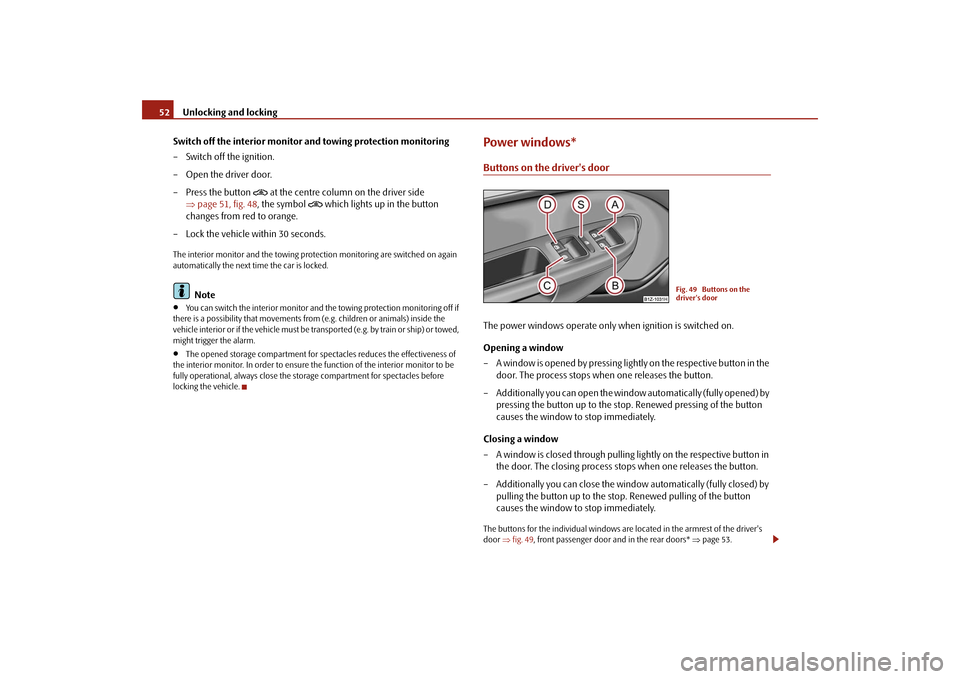
Unlocking and locking
52
Switch off the interior monitor and towing protection monitoring – Switch off the ignition. – Open the driver door. – Press the button
at the centre column on the driver side
⇒
page 51, fig. 48
, the symbol
which lights up in the button
changes from red to orange.
– Lock the vehicle within 30 seconds.The interior monitor and the towing protec
tion monitoring are switched on again
automatically the next ti
me the car is locked.
Note
•
You can switch the interior monitor and th
e towing protection monitoring off if
there is a possibility that movements from (e.g. children or animals) inside the vehicle interior or if the vehicle must be transported (e.g. by train or ship) or towed, might trigger the alarm.•
The opened storage compartment for spectacles reduces the effectiveness of
the interior monitor. In order to ensure the function of the interior monitor to be fully operational, always close the stor
age compartment for spectacles before
locking the vehicle.
Power windows*Buttons on the driver's doorThe power windows operate only when ignition is switched on. Opening a window – A window is opened by pressing lightly on the respective button in the
door. The process stops when one releases the button.
– Additionally you can open the window automatically (fully opened) by
pressing the button up to the stop. Renewed pressing of the button causes the window to stop immediately.
Closing a window – A window is closed through pulling lightly on the respective button in
the door. The closing process stops when one releases the button.
– Additionally you can close the window automatically (fully closed) by
pulling the button up to the stop. Renewed pulling of the button causes the window to stop immediately.
The buttons for the individual windows are located in the armrest of the driver's door
⇒fig. 49
, front passenger door and in the rear doors*
⇒page 53.
Fig. 49 Buttons on the driver's door
se0.1.book Page 52 Friday, April 10, 2009 3:19 PM
Page 54 of 304

Unlocking and locking
53
Using the system
Safety
Driving Tips
General Maintenance
Breakdown assistance
Technical Data
Buttons for the power windows in the armrest for the driver Button for the power window in the driver's door Button for the power window in the front passenger's door Button for the power window in the rear door on the right* Button for the power window in the rear door on the left* Safety pushbutton* Safety pushbutton* You can deactivate the switches for power
windows at rear door
s by pressing the
safety pushbutton
⇒page 52, fig. 49
. The buttons for power windows at rear
doors are activated again by pressing the safety pushbutton again. If the buttons for the rear doors are deactivated, the indicator light
in the safety
switch lights up.
WARNING
•
If you lock the vehicle from the outside, do not leave any person in the
vehicle since it is no long
er possible to open the windows from the inside in
an emergency.•
The system is fitted with a force limiter
⇒page 54. If there is an obstacle,
the closing process is stopped and the
window goes down by several centim-
eters. You should then take particular care when closing the windows! You may otherwise suffer severe injuries
as a result of getting an arm, for
example, jammed in the window!•
It is recommended to deactivate
the electrically operated power
windows in the rear doors (safety pushbutton)
⇒page 52, fig. 49
when
children are being transported on the rear seats.
Note
•
After switching the ignition off, it is still possible to open or close the windows
for a further 10 minutes. During this time the automatic closing and opening func-tions of the window will operate. The po
wer windows are switched off completely
once you open the driver or front passenger door.
•
When driving always use the existing he
ating, air conditioning and ventilation
system for ventilating the interior of the vehicle. If the windows are opened, dust as well as other dirt can get into the vehicle and in addition the wind noise is more at certain speeds.Button in front passenger door and in rear doorsA button for the relevant window is provided in these doors. Opening a window – Lightly press the appropriate switch
down
and hold it until the
window has moved into the desired position.
– Additionally you can open the window
automatically (fully opened) by
pressing the switch
down
up to the stop. Renewed pressing of the
button causes the window to stop immediately.
Closing a window – Lightly press the appropriate switch
up and hold it until the window
has moved into the desired position.
AAABACADAS
AS
AS
AS
AS
Fig. 50 Position of button in front passenger door
se0.1.book Page 53 Friday, April 10, 2009 3:19 PM
Page 55 of 304

Unlocking and locking
54
– Additionally you can close the window automatically (fully closed) by
pressing the switch
up up to the stop. Renewed pressing of the button
causes the window to stop immediately.
WARNING
The system is fitted with a force limiter
⇒page 54. If there is an obstacle, the
closing process is stopped and the window goes down by several centime-ters. You should then take particular care when closing the windows! You may otherwise suffer severe injuries
as a result of getting an arm, for
example, jammed in the window!
Note
•
After switching the ignition off, it is st
ill possible to open or close the windows
for a further 10 minutes. The automatic closing and opening functions will not operate during this time. The power windows are switched off completely once you open the driver or front passenger door.•
If the child safety lock is switched on,
the lighting of the switch for the window
lifter in the rear doors* is not activated.Force limiter of the power windowsThe electrically operated power windows are fitted with a force limiter. It reduces the risk of bruises or injuries when closing the windows. If there is an obstacle, the closing proce
ss is stopped and the window goes down by
several centimeters. If the obstacle prevents the window from
being closed during the next 10 seconds,
the closing process is interrupted once ag
ain and the window go
e s d o w n b y s e v e ra l
centimeters. You must try to close the window once
again within 10 seconds after the window
has gone down twice, even if the obstacle
was not yet removed, the closing process
is stopped. During this time it is not possible to automatically close the window. The force limiter is still switched on.
The force limiter is only switched off, if
you attempt to close the window within the
next 10 seconds -
the window closes now with full strength!
If you wait longer than 10 seconds, the force limiter is switched on again.
WARNING
You should take particular care when closing the windows! You may other- wise suffer severe injuries as a result
of getting an arm, for example, jammed
in the window!Window convenience operationYou can open and close the electrically powered windows as follows when unlocking and locking the vehicle (just closing of the sliding roof). Opening a window – Hold the key in the locking cylinder
of the driver's door in the opening
position or press the opening button
of the radio remote control until
all the windows are opened.
Closing a window – Turn the key in the lock of the driver door into the closing position or
press the closing button of the radio remote control until all the windows are closed.
You can interrupt the opening or closing operation of the windows immediately by releasing the key or the lock button.
WARNING
The system is fitted with a force limiter
⇒page 54. If there is an obstacle, the
closing process is stopped and the wi
ndow goes down by several centime-
ters. You should then take particular care when closing the windows! You
se0.1.book Page 54 Friday, April 10, 2009 3:19 PM
Page 56 of 304

Unlocking and locking
55
Using the system
Safety
Driving Tips
General Maintenance
Breakdown assistance
Technical Data
may otherwise suffer severe injuries
as a result of getting an arm, for
example, jammed in the window!
Note
On vehicles fitted with anti-theft alarm
system the convenience window opening is
possible by means of the key in the lock
ing cylinder only 45 seconds after deacti-
vating the warning system or after ac
tivating the anti-theft alarm system.
Operational faultsElectrically operated power windows do not operate If the battery of the car has been discon
nected and then reconnected, the electri-
cally operated power windows do not oper
ate. The system must be activated.
Proceed as follows in order to re-establish the function:•
Switch on the ignition.
•
Press the relevant switch
top
and hold it pressed as lo
ng as necessary until the
window is closed.•
Release the switch.
•
Press once again the relevant switch
top
and hold it pressed for approx. 3
seconds. Operation in winter Ice accumulating on the surface of the wi
ndows during the winter may result in a
greater resistance when closing the windows and the window may stop and go down several centimetres It is necessary to put the force limiter out of operation in order to close the window ⇒ page 54, “Force limiter of the power windows”.
WARNING
The system is fitted with a force limiter
⇒page 54. If there is an obstacle, the
closing process is stopped and the wi
ndow goes down by several centime-
ters. You should then take particular care when closing the windows! You may otherwise suffer severe injuries as a result of getting an arm, for example, jammed in the window!Electric sliding/tilting roof*DescriptionThe sliding/tilting roof is operated by means of the control dial
⇒fig. 51
and only
functions when the ignition is switched on
. The control dial has a number of fixed
positions. After switching the ignition off, it is still possible to open or close the sliding/tilting roof for a further 10 minutes. It is no long
er possible to operate the sliding/tilting
roof after opening or closing on
e of the front doors, however.
Note
If the battery has been disconnected and reconnected, it is possible that the sliding/tilting roof does not close fully. Here you have to set the control dial to the switch position and press it
forward for about 10 seconds.
WARNING (continued)
WARNING (continued)
Fig. 51 Control dial for the power sliding/tilting roof
AA
se0.1.book Page 55 Friday, April 10, 2009 3:19 PM
Page 57 of 304
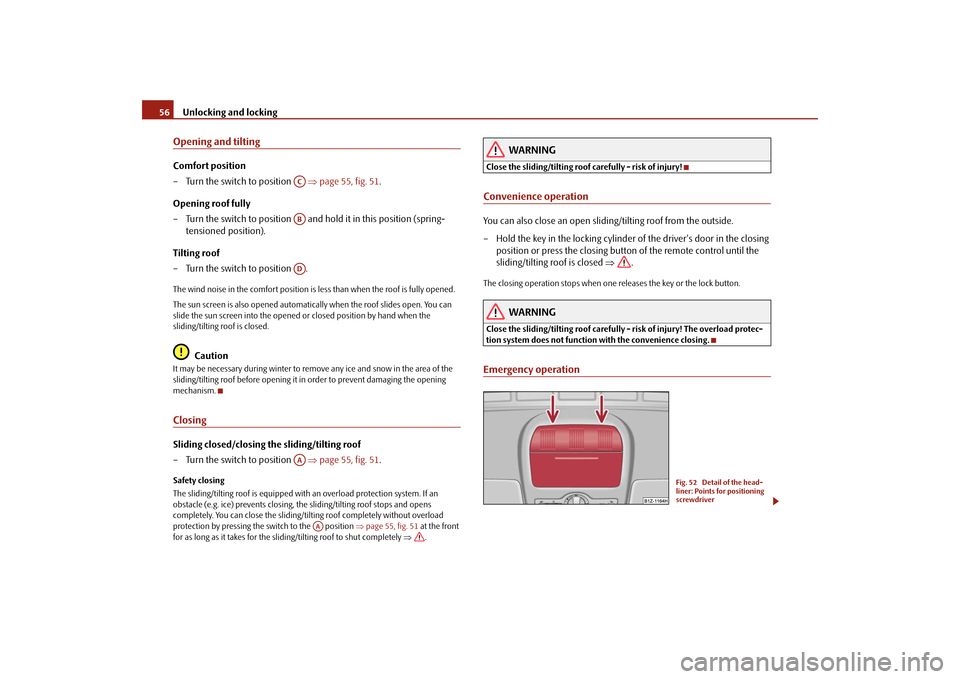
Unlocking and locking
56
Opening and tiltingComfort position – Turn the switch to position
⇒
page 55, fig. 51
.
Opening roof fully – Turn the switch to position and
hold it in this position (spring-
tensioned position).
Tilting roof – Turn the switch to position .The wind noise in the comfort position is
less than when the roof is fully opened.
The sun screen is also opened automatically when the roof slides open. You can slide the sun screen into the opened or closed position by hand when the sliding/tilting roof is closed.
Caution
It may be necessary during winter to remove any ice and snow in the area of the sliding/tilting roof before opening it in order to prevent damaging the opening mechanism.ClosingSliding closed/closing the sliding/tilting roof – Turn the switch to position
⇒
page 55, fig. 51
.
Safety closing The sliding/tilting roof is equipped with an overload protection system. If an obstacle (e.g. ice) prevents closing,
the sliding/tilting roof stops and opens
completely. You can close the sliding/tilting roof completely without overload protection by pressing the
switch to the position
⇒page 55, fig. 51
at the front
for as long as it takes for the sliding/tilting roof to shut completely
⇒
.
WARNING
Close the sliding/tilting roof carefully - risk of injury!Convenience operationYou can also close an open sliding/tilting roof from the outside. – Hold the key in the locking cylinder
of the driver's door in the closing
position or press the closing button of the remote control until the sliding/tilting roof is closed
⇒
.
The closing operation stops when one releases the key or the lock button.
WARNING
Close the sliding/tilting roof carefully
- risk of injury! The overload protec-
tion system does not function with the convenience closing.Emergency operation
ACABADAA
AA
Fig. 52 Detail of the head- liner: Points for positioning screwdriver
se0.1.book Page 56 Friday, April 10, 2009 3:19 PM
Page 58 of 304

Unlocking and locking
57
Using the system
Safety
Driving Tips
General Maintenance
Breakdown assistance
Technical Data
You can close and/or open the sliding/ti
lting roof by hand if the system is
defect. – Position the flat blade of a screwdriver carefully against the rear edge
of the cover of the electrical drive
⇒
page 56, fig. 52
.
– Pull the cover down.– Insert an Allen key, Group 4, up to the stop into the opening and close
and/or open the sliding/tilting roof
⇒
fig. 53
.
– Press on the cover again by first of all inserting the plastic lugs and
then pushing the cover up.
– Have the fault rectified by a specialist workshop.
Note
It is necessary after each emergency operation to move the sliding/tilting roof into the basic position. Here you have to turn th
e control dial forward to the switch posi-
tion
⇒page 55, fig. 51
and press for about 10 seconds.
Fig. 53 Detail of the head- liner: Emergency operation
AA
se0.1.book Page 57 Friday, April 10, 2009 3:19 PM
Page 59 of 304
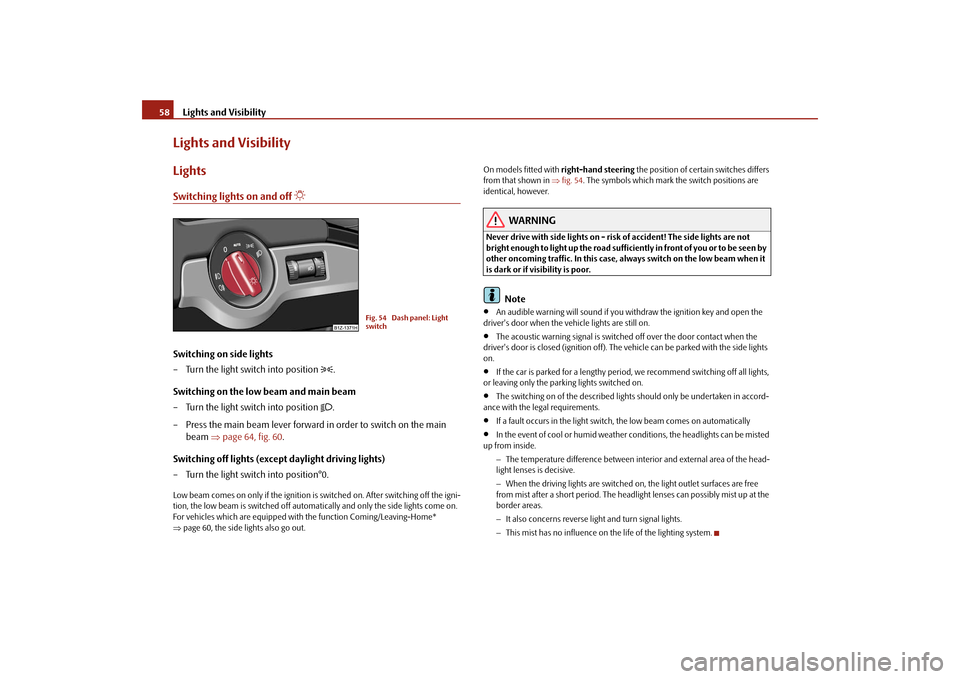
Lights and Visibility
58
Lights and VisibilityLightsSwitching lights on and off
Switching on side lights – Turn the light switch into position
.
Switching on the low beam and main beam – Turn the light switch into position
.
– Press the main beam lever forward in order to switch on the main
beam
⇒
page 64, fig. 60
.
Switching off lights (except daylight driving lights) – Turn the light switch into position°0.Low beam comes on only if the ignition is switched on. After switching off the igni- tion, the low beam is switched off automati
cally and only the side lights come on.
For vehicles which are equipped with
the function Comi
ng/Leaving-Home*
⇒ page 60, the side lights also go out.
On models fitted with
right-hand steering
the position of certain switches differs
from that shown in
⇒fig. 54
. The symbols which mark the switch positions are
identical, however.
WARNING
Never drive with side lights on - risk of accident! The side lights are not bright enough to light up the road sufficiently in front of you or to be seen by other oncoming traffic. In this case, always switch on the low beam when it is dark or if visibility is poor.
Note
•
An audible warning will sound if you withdraw the ignition key and open the
driver's door when the vehicle lights are still on.•
The acoustic warning signal is switched off over the door contact when the
driver's door is closed (ignition off). The
vehicle can be parked with the side lights
on.•
If the car is parked for a lengthy period
, we recommend switching off all lights,
or leaving only the parking lights switched on.•
The switching on of the described lights
should only be undertaken in accord-
ance with the legal requirements.•
If a fault occurs in the light switch, the low beam comes on automatically
•
In the event of cool or humid weather co
nditions, the headligh
ts can be misted
up from inside.
− The temperature difference between interior and external area of the head- light lenses is decisive. − When the driving lights are switched on, the light outlet surfaces are free from mist after a short period. The headli
ght lenses can possib
ly mist up at the
border areas. − It also concerns reverse light and turn signal lights. − This mist has no influence on th
e life of the lighting system.
Fig. 54 Dash panel: Light switch
se0.1.book Page 58 Friday, April 10, 2009 3:19 PM
Page 60 of 304
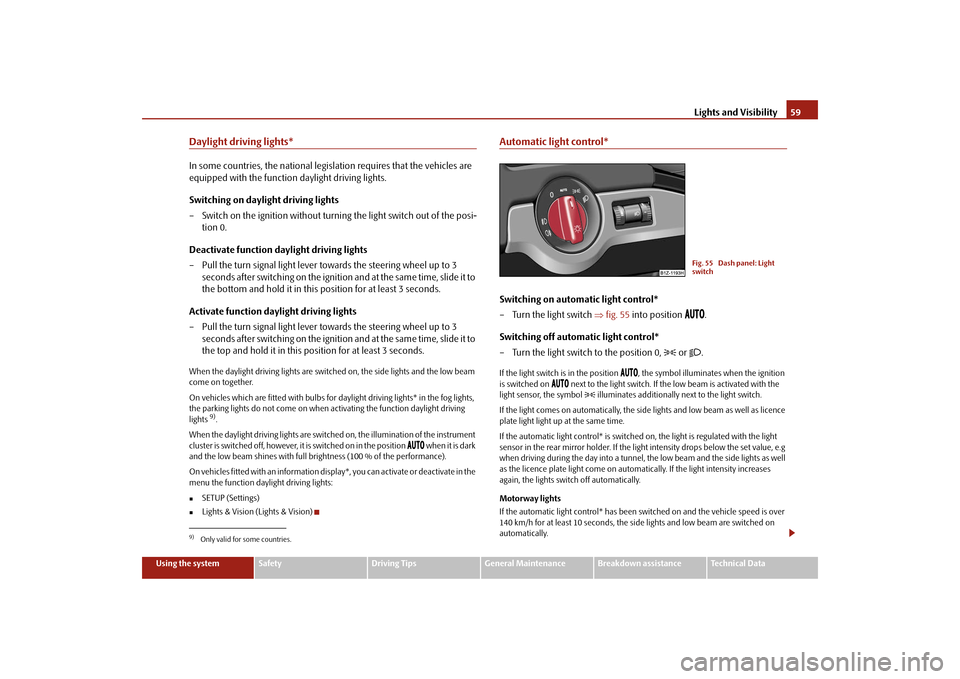
Lights and Visibility
59
Using the system
Safety
Driving Tips
General Maintenance
Breakdown assistance
Technical Data
Daylight driving lights*In some countries, the national legisl
ation requires that the vehicles are
equipped with the function
daylight driving lights.
Switching on daylight driving lights – Switch on the ignition without turnin
g the light switch out of the posi-
tion 0.
Deactivate function daylight driving lights – Pull the turn signal light lever towards the steering wheel up to 3
seconds after switching on the ignition
and at the same time, slide it to
the bottom and hold it in this position for at least 3 seconds.
Activate function daylight driving lights – Pull the turn signal light lever towards the steering wheel up to 3
seconds after switching on the ignition
and at the same time, slide it to
the top and hold it in this position for at least 3 seconds.
When the daylight driving lights are switched on, the side lights and the low beam come on together. On vehicles which are fitted with bulbs for
daylight driving lights* in the fog lights,
the parking lights do not co
me on when activating the function daylight driving
lights
9).
When the daylight driving lights are switched on, the illumination of the instrument cluster is switched off, however, it is switched on in the position
when it is dark
and the low beam shines with full brightness (100 % of the performance). On vehicles fitted with an information displa
y*, you can activate or
deactivate in the
menu the function daylight driving lights:�„
SETUP (Settings)
�„
Lights & Vision (Lights & Vision)
Automatic light control*Switching on automatic light control* – Turn the light switch
⇒
fig. 55
into position
.
Switching off automatic light control* – Turn the light switch to the position 0,
or
.
If the light switch is in the position
, the symbol illuminates when the ignition
is switched on
next to the light switch. If th
e low beam is activated with the
light sensor, the symbol
illuminates additionally next to the light switch.
If the light comes on automatically, the side lights and low beam as well as licence plate light light up at the same time. If the automatic light control* is switched on, the light is regulated with the light sensor in the rear mirror holder. If the light intensity drops below the set value, e.g when driving during the day into a tunnel, the low beam and the side lights as well as the licence plate light come on automa
tically. If the light intensity increases
again, the lights switch off automatically. Motorway lights If the automatic light control* has been sw
itched on and the vehicle speed is over
140 km/h for at least 10 seconds, the side
lights and low beam are switched on
automatically.
9)Only valid for some countries.
Fig. 55 Dash panel: Light switch
se0.1.book Page 59 Friday, April 10, 2009 3:19 PM